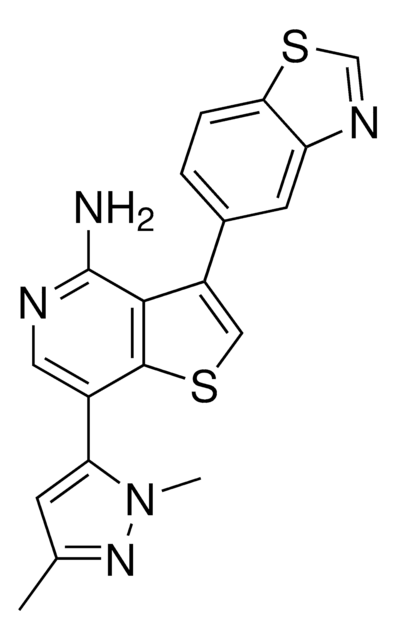おすすめの製品
アッセイ
≥98% (HPLC)
フォーム
powder
色
white to beige
溶解性
DMSO: 2 mg/mL, clear
保管温度
2-8°C
SMILES記法
O=C(C(C)(C)C)N1[C@H](C2=CC=CC=C2)CC=N1
生物化学的/生理学的作用
Brain-penetrant, highly potent and selective RIPK1 (RIP1) inhibitor with necroptosis blocking efficacy in vitro and in vivo.
GSK′963 (GSK′963A) is a brain-penetrant, highly potent and selective ATP site-targeting receptor-interacting protein 1 kinase (RIP1; RIPK1) inhibitor (IC50 = 0.8-8 nM with 50 μM ATP; IC50 >10 μM against RIPK2/3/5 and 335 other kinases) that protects against TNFα/zVAD-induced necroptosis (EC50 = 1/4 nM in mouse L929/human U937 cultures) and blocks Y. pestis-induced death of murine fetal liver macrophages (1 μM). GSK′963 prevents lethal hypothermia by acute sterile shock (2 mg/kg i.p. 15 min prior to TNFα/zVAD i.v.) and protects against acute neuronal death upon autologous blood intracerebral hemorrhage induction in mice in vivo (25 mg/kg/3 hr i.p.).
保管分類コード
11 - Combustible Solids
WGK
WGK 3
引火点(°F)
Not applicable
引火点(℃)
Not applicable
適用法令
試験研究用途を考慮した関連法令を主に挙げております。化学物質以外については、一部の情報のみ提供しています。 製品を安全かつ合法的に使用することは、使用者の義務です。最新情報により修正される場合があります。WEBの反映には時間を要することがあるため、適宜SDSをご参照ください。
Jan Code
SML2376-5MG:
SML2376-VAR:
SML2376-BULK:
SML2376-25MG:
最新バージョンのいずれかを選択してください:
試験成績書(COA)
Lot/Batch Number
Hongyan Guo et al.
Cell host & microbe, 17(2), 243-251 (2015-02-13)
Herpes simplex virus (HSV)-1 and HSV-2 are significant human pathogens causing recurrent disease. During infection, HSV modulates cell death pathways using the large subunit (R1) of ribonucleotide reductase (RR) to suppress apoptosis by binding to and blocking caspase-8. Here, we demonstrate
Sevda Lule et al.
Stroke, 48(9), 2549-2556 (2017-08-03)
Recent studies using cultured cells and rodent intracerebral hemorrhage (ICH) models have implicated RIPK1 (receptor interacting protein kinase-1) as a driver of programmed necrosis and secondary injury based on use of chemical inhibitors. However, these inhibitors have off-target effects and
Anne von Mässenhausen et al.
Cell death & disease, 9(3), 359-359 (2018-03-04)
Receptor-interacting protein kinases 1 and 3 (RIPK1/3) have best been described for their role in mediating a regulated form of necrosis, referred to as necroptosis. During this process, RIPK3 phosphorylates mixed lineage kinase domain-like (MLKL) to cause plasma membrane rupture.
Wenjing Liu et al.
Proceedings of the National Academy of Sciences of the United States of America, 115(7), E1475-E1484 (2018-02-01)
Tubular cell necrosis is a key histological feature of acute kidney injury (AKI). Necroptosis is a type of programed necrosis, which is executed by mixed lineage kinase domain-like protein (MLKL) upon its binding to the plasma membrane. Emerging evidence indicates
Mallary C Greenlee-Wacker et al.
Blood, 129(24), 3237-3244 (2017-05-06)
Community-associated methicillin-resistant Staphylococcus aureus (CA-MRSA) causes infections associated with extensive tissue damage and necrosis. In vitro, human neutrophils fed CA-MRSA lyse by an unknown mechanism that is inhibited by necrostatin-1, an allosteric inhibitor of receptor-interacting serine/threonine kinase 1 (RIPK-1). RIPK-1
ライフサイエンス、有機合成、材料科学、クロマトグラフィー、分析など、あらゆる分野の研究に経験のあるメンバーがおります。.
製品に関するお問い合わせはこちら(テクニカルサービス)








